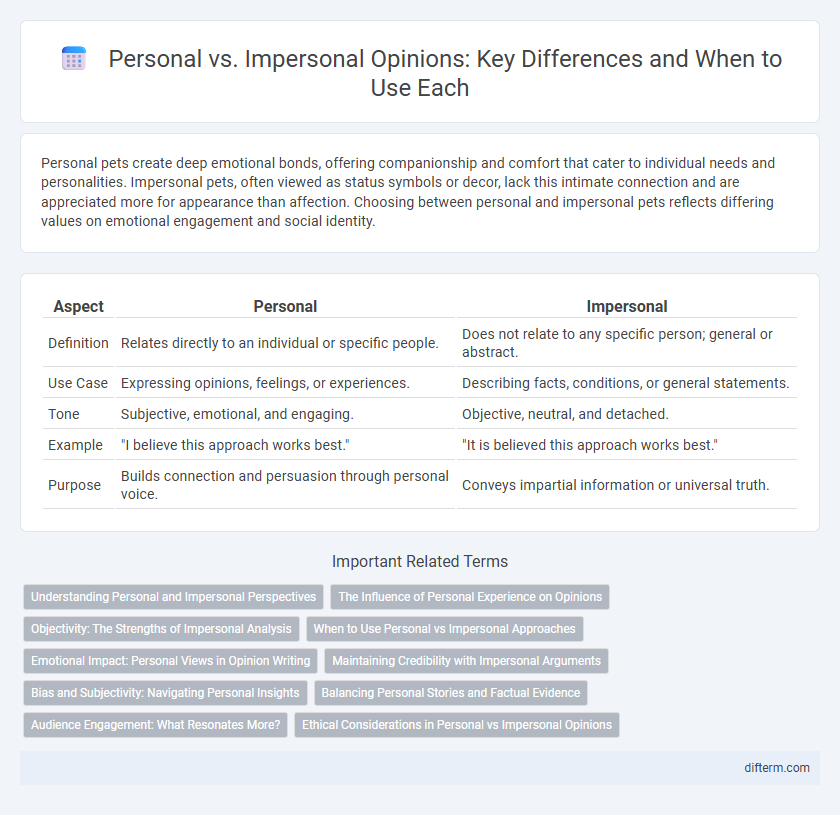Personal pets create deep emotional bonds, offering companionship and comfort that cater to individual needs and personalities. Impersonal pets, often viewed as status symbols or decor, lack this intimate connection and are appreciated more for appearance than affection. Choosing between personal and impersonal pets reflects differing values on emotional engagement and social identity.
Table of Comparison
| Aspect | Personal | Impersonal |
|---|---|---|
| Definition | Relates directly to an individual or specific people. | Does not relate to any specific person; general or abstract. |
| Use Case | Expressing opinions, feelings, or experiences. | Describing facts, conditions, or general statements. |
| Tone | Subjective, emotional, and engaging. | Objective, neutral, and detached. |
| Example | "I believe this approach works best." | "It is believed this approach works best." |
| Purpose | Builds connection and persuasion through personal voice. | Conveys impartial information or universal truth. |
Understanding Personal and Impersonal Perspectives
Understanding personal perspectives involves recognizing the unique emotions, experiences, and values that shape an individual's viewpoint, which creates a deeper connection and empathy in communication. Impersonal perspectives emphasize objective facts, general principles, and unbiased analysis, which enhance clarity and reduce emotional influence in decision-making. Balancing personal and impersonal viewpoints allows for a comprehensive analysis that respects individual experiences while maintaining logical consistency.
The Influence of Personal Experience on Opinions
Personal experience profoundly shapes opinions by providing unique, firsthand insights that objective facts alone cannot offer. Individual encounters and emotions color perceptions, leading to diverse interpretations of the same event or topic. This subjective lens often results in opinions that resonate deeply on a personal level but may lack universal applicability.
Objectivity: The Strengths of Impersonal Analysis
Impersonal analysis excels in delivering objective insights by minimizing personal biases and emotional influence, ensuring decisions are based on verifiable data and factual evidence. This approach enhances credibility and consistency, especially in academic research, scientific studies, and professional evaluations. The reliance on neutral language and standardized metrics allows impersonal analysis to provide clear, actionable conclusions applicable across diverse contexts.
When to Use Personal vs Impersonal Approaches
Personal approaches foster trust and emotional connection, making them ideal for situations requiring empathy and individualized communication, such as counseling or customer service. Impersonal approaches suit formal, data-driven contexts where objectivity and professionalism are paramount, like academic writing or corporate reports. Selecting between these approaches depends on the audience, purpose, and desired impact of the message.
Emotional Impact: Personal Views in Opinion Writing
Personal opinions in writing evoke stronger emotional connections by incorporating individual experiences and feelings that resonate deeply with readers. Impersonal opinions, while objective, often lack the emotional nuance that makes arguments compelling and memorable. Emphasizing personal perspectives enhances persuasive impact by appealing directly to the audience's empathy and shared values.
Maintaining Credibility with Impersonal Arguments
Maintaining credibility with impersonal arguments relies on presenting evidence-based reasoning and objective data instead of subjective opinions. This approach strengthens trustworthiness by minimizing bias and emphasizing facts, which appeals to a broader audience. Incorporating authoritative sources and statistical information enhances the persuasive impact while preserving the writer's professionalism.
Bias and Subjectivity: Navigating Personal Insights
Personal insights often introduce bias and subjectivity, shaping opinions through individual experiences and emotions. Impersonal perspectives aim to minimize such bias by relying on objective data and universal principles. Balancing these approaches enhances critical thinking and fosters more nuanced understanding in discussions.
Balancing Personal Stories and Factual Evidence
Balancing personal stories and factual evidence enhances the credibility and relatability of an opinion. Integrating authentic experiences humanizes abstract data, making complex information more accessible and engaging for readers. This synergy strengthens arguments by appealing to both emotion and logic, fostering trust and deeper understanding.
Audience Engagement: What Resonates More?
Personal communication fosters deeper audience engagement by creating emotional connections and relatability, which enhances message retention and response. Impersonal approaches may reach broader audiences but often lack the emotional impact necessary for sustained interest and interaction. Tailoring content with personal anecdotes or direct address typically resonates more effectively across diverse demographics.
Ethical Considerations in Personal vs Impersonal Opinions
Ethical considerations in personal versus impersonal opinions hinge on accountability and respect for diverse perspectives. Personal opinions often reveal biases and emotional investments, demanding responsibility for potential impacts on others. Impersonal opinions strive for objectivity, promoting fairness but risk detachment from human values and ethical nuances.
Personal vs Impersonal Infographic

 difterm.com
difterm.com